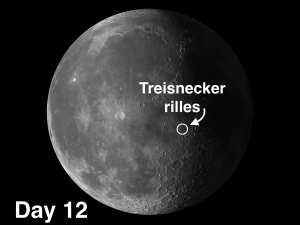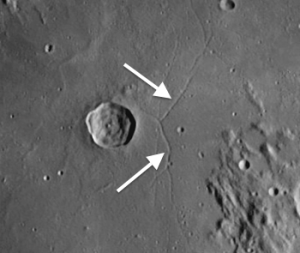 The week of September 11-17 takes us from Day 21 to Day 27. The Moon will not be in a good position for viewing until about 1:00 AM on Tuesday. This week we will highlight the Triesnecker rilles, visible early Tuesday morning.
The week of September 11-17 takes us from Day 21 to Day 27. The Moon will not be in a good position for viewing until about 1:00 AM on Tuesday. This week we will highlight the Triesnecker rilles, visible early Tuesday morning.
Rimae Triesnecker: [NE/J10] What a great place to poke around with your telescope! This is such a complex system of rilles that it looks like a railway switchyard! Before looking at the footnote, which do you think came first, the crater or the rilles?
 The width of the rilles measures between one-half mile and one mile. The largest rilles can be seen in a three-inch refractor, but the whole system requires larger apertures and good seeing. There are at least nine rilles crisscrossing each other. Make a sketch of how many you can see, then come back later and try to improve on it.
The width of the rilles measures between one-half mile and one mile. The largest rilles can be seen in a three-inch refractor, but the whole system requires larger apertures and good seeing. There are at least nine rilles crisscrossing each other. Make a sketch of how many you can see, then come back later and try to improve on it.
Scientists are not sure how the Triesnecker rilles developed. Their origin still remains a mystery, but the consensus is they are not grabens (as the Ariadaeus rille is [NE/J11]). Enjoy them as one of the Moon’s many enigmas.
WHAT’S HOT ON THE MOON TONIGHT THE WEEK OF SEPTEMBER 11-17:
On Tuesday morning, just on the edge between nautical and civil twilight, the Moon will occult Aldebaran and will be visible before or during dawn in the west.
1 There is a rille approaching Triesnecker’s northeast rim that looks like it has been interrupted by the crater, suggesting that the rilles were there first.
2 graben: [German for ditch] an elongated depression between two parallel fault lines. These lines occasionally pull apart with such force that the ground between them drops. Rima Ariadaeus [Visible Monday morning & on Day 6; NE/J11] and the Alpine Valley [Visible tonight & Day 7; NE/E10] are excellent examples of grabens. Lunar grabens have their counterparts on Earth. Examples are Death Valley, parts of the Rhine Valley, and the Rift Valley in Africa.
======================
It is highly recommended that you get a copy of Sky and Telescope’s Field Map of the Moon, the very finest Moon map available for use at the telescope. It is available for $10.95 at www.skyandtelescope.com and on Amazon. All features mentioned in this blog will be keyed to the grid on the Field Map and will look like this: Plato: [NW/D9]
Credits:
Courtesy of Gray Photography of Corpus Christi, Texas
Lunar photos: NASA / USGS / BMDO / LROC / ASU / DLR / LOLA / Moon Globe. Used by permission
- Rupes Cauchy: A Best Known Fault on the Moon - July 22, 2024
- Moon Crater Schickard – Crater Floor has Stripes - July 15, 2024
- Moon Craters Langrenus and Vandelinus - July 8, 2024